Growth hacking is one of the biggest buzzwords of the past years, and in 2024, it’s no different, which is why so many people are asking, “What is Growth Hacking?”.
Consultants, marketers, and entrepreneurs call growth hacking the best way they grow a business, and some even call it ‘the future of marketing’, but what does it really mean?
In this article, I’ll give a clear definition and explain what growth hacking is and how growth hacking works. Let’s get started with the definition of growth hacking:
What is Growth Hacking?
Growth Hacking is a new field focusing solely on growth, based on a data-driven, experiment-based process.
A growth hacker explores new growth opportunities systematically in any part of the customer journey, from awareness through marketing to brand ambassadors by optimizing the product.


The origin of growth hacking comes from 2010 when Sean Ellis coined the term and has mostly been popular among startups, because of the limited budgets and resources. Since then, more people stood up and started calling themselves a growth hacker, growth marketer, technical marketeer, data-driven marketer or head of growth.
Ever since it has seen a huge increase in popularity among scale-ups and larger, traditional companies. Companies like Uber, TikTok or Shopify have their own VP/Head of Growth and dedicated growth team(s).
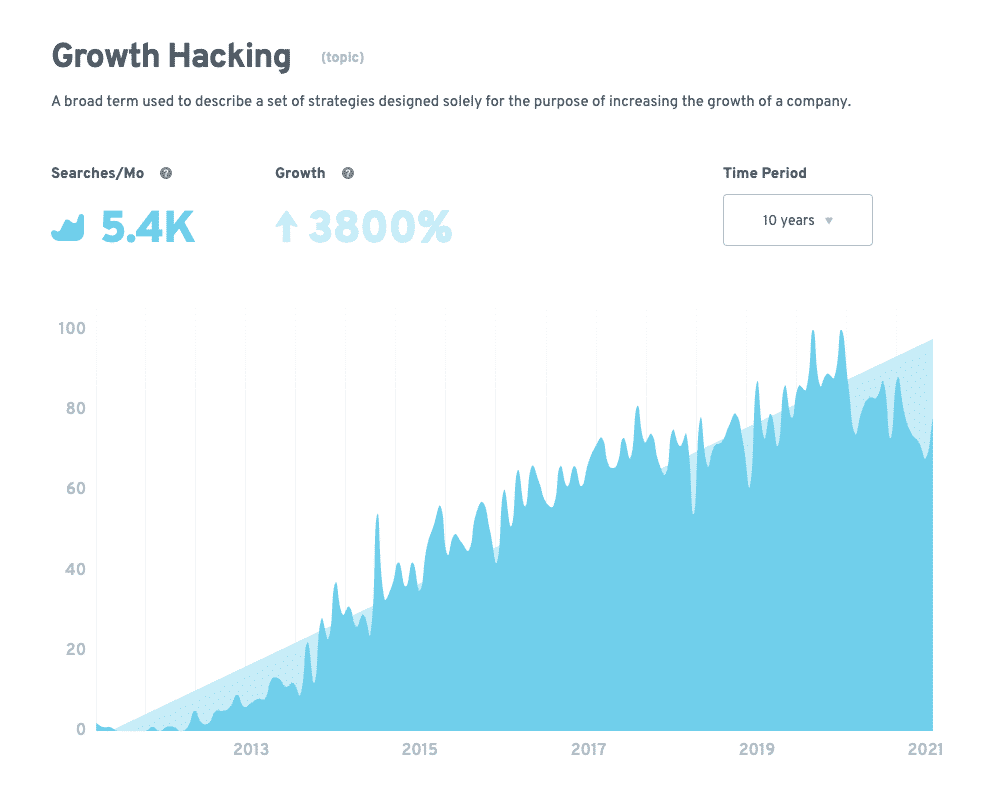
What is the difference between Growth Hacking versus Marketing?
“But Ward, isn’t that just the modern way to do marketing? Isn’t Growth Hacking just ‘marketing-done-well’?”
I have to confess that the difference isn’t that big at some times. In my opinion, there are several differences in job description between growth hackers versus traditional marketers, that you can’t put those two in the one basket, and that makes that growth hacking deserves its own term.
For this reason, many people and especially in enterprise business use the term ‘Growth Marketing‘ to keep it simple (and for the bad associations with the word ‘hacking’).
There are six differences between marketing versus growth hacking:
- A growth hacker focuses on next growth opportunities, while marketers are often already too busy with current day-to-day marketing and branding.
- A growth hacker uses the entire funnel, including Retention and Referral, where most marketers look at Awareness and Acquisition.
- A growth hacker runs small experiments; he tests which directions work best/show most potential, where a marketer often works on bigger, long-term projects.
- A growth hacker works data-driven, where that is not the case for most marketing departments.
- A growth hacker has more technical skills, such as programming, tooling and automation.
- A growth hacker is involved in the product, because, among other things, he has to pay attention to the retention of active customers.

What does a Growth Hacker do?
Skills of a Growth Hacker
As a growth hacker, you have to be able to work quickly and therefore you have to be as independent as possible. That is why it is important for a growth hacker to be able to program, handle data and design. He/she does not have to be an expert in everything, but in any case, has to understand the basis to be able to execute the biggest part by themselves.
You need a broad skill set: knowledge of data is necessary because that is the only way to find your main problem and its cause. Then comes creativity to come up with solutions for this problem and finally, a growth hacker needs technical skills to bring these solutions to reality. Hence these are the skills of a T-shaped Growth Hacker:
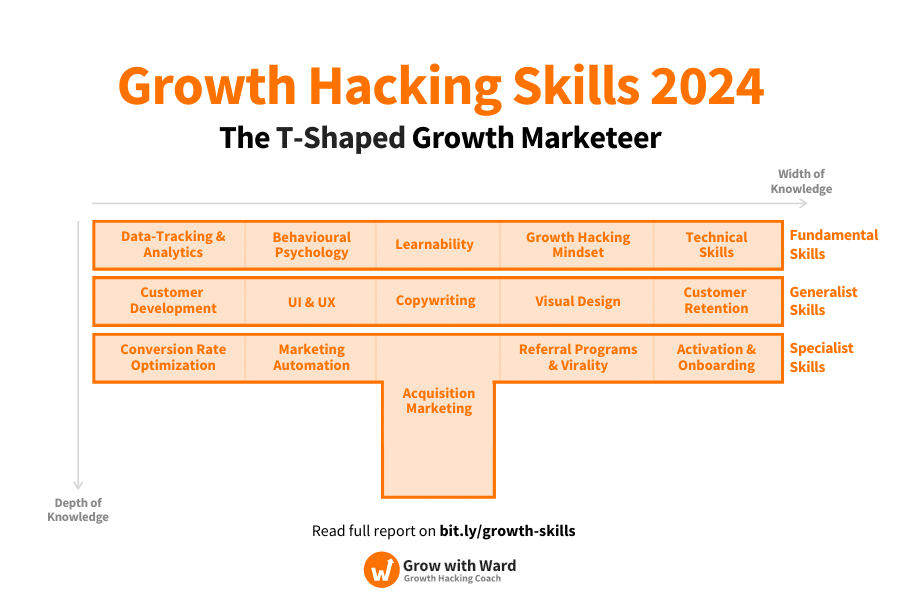
A growth hacker should have 20% of all the knowledge needed to execute 80% of the work. It is therefore much more efficient to at least master the basics of the fundamental and generalistic growth hacking skills and a large arsenal of growth hacking tools, while learning the Specialist Skills on the job.
Which technical skills should a growth hacker have?
- Build landing pages
- Build websites
- Design and understand colors, fonts, branding, etc.
- Run ads on channels like AdWords, Facebook, LinkedIn, etc.
- Basic HTML and CSS
- Implement tracking tools like Google Tag Manager, Google Analytics, Hotjar, etc.
- And many more concepts/techniques, like conversion rate optimization, Artificial Intelligence in marketing, web scraping, chatbots, API’s, etc.
A Growth Hacking mindset
The question “What is Growth Hacking?” is such a difficult question, because above all growth hacking is a way of thinking/working, commonly referred to as the ‘Growth Hacking Mindset‘.
A growth hacker sets the goal above the means; growing his ‘North Star Metric‘ is his main goal and which channel, technique or tool is used for this is secondary. That is why it is so important that a growth hacker has a broad set of knowledge and skills.
Having a growth hacking mindset, means:
- Speed > Perfection: It’s better to see quickly if something has potential, versus building it from start-to-end, only to find out that you misinterpreted your customer. You see this come back through the experiments and the less-talking-more-doing mentality.
- Make data-driven decisions: By using data, you can positively improve your effectiveness. Where to focus your time and resources for the most significant impact? What improvement would bring the most growth based on data from our experiments? Which type of users is most valuable?
- Always be improving (both in business and personal): There is always a new bottleneck in your business’s growth to tackle. And in personal terms, you learn to have a high level of “Learnability”: If you don’t know how something works, you just start to Google it to find out.
Here you have a video explaining what growth hacking is (based on the book Growth Hacker Marketing by Ryan Holiday):
Famous growth hacking examples
The examples below are a few of the best-known growth hacks.
Dropbox and their referral-program
Dropbox was one of the first companies to use a referral program to make their customers work as acquisition channels. They offered users 250MB of extra storage space for every friend they would bring in as a new user. You could easily invite your friends via Facebook or Twitter, or import your email contacts to send them an automatic invitation.
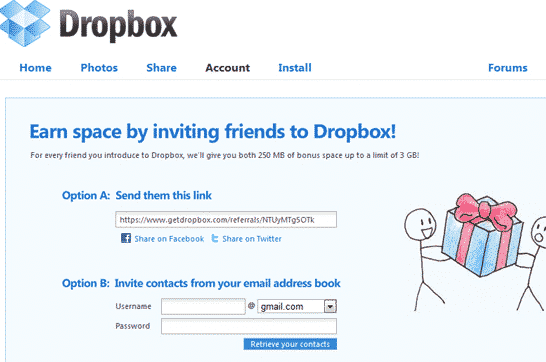
It was a great success and Dropbox grew from 100,000 users in late 2008 to 4 million users in early 2010! At the peak, 2.8 million invitations were sent per month. Most channels can’t compete with such a viral ‘Growth Loop‘.
AirBnB and their Craigslist-integration
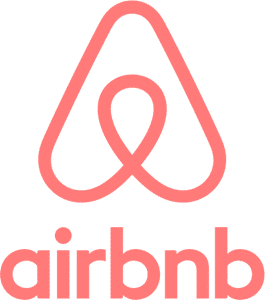
The example of AirBnB is a good example of using someone else’s platform. AirBnB used Craigslist in their early years. Craigslist was at that time the largest forum where people could rent a house. This was therefore the place where their target group was most active.
AirBnB began to place their own offer on Craigslist with a link to their own platform for potential tenants who sought more information. This way they managed to attract their launching customers from Craigslist and people kept hanging on AirBnB.
As an experiment they first performed this manually and later made a bot that could automatically place it on Craigslist and attract people to their app.
Hotmail with “P.s. I love you”
Hotmail was the first free email provider. At the bottom of all the emails from their users they placed the phrase “P.s. I love you” with a link to their own website. As soon as recipients visited the website and saw that Hotmail was free, they switched to Hotmail.
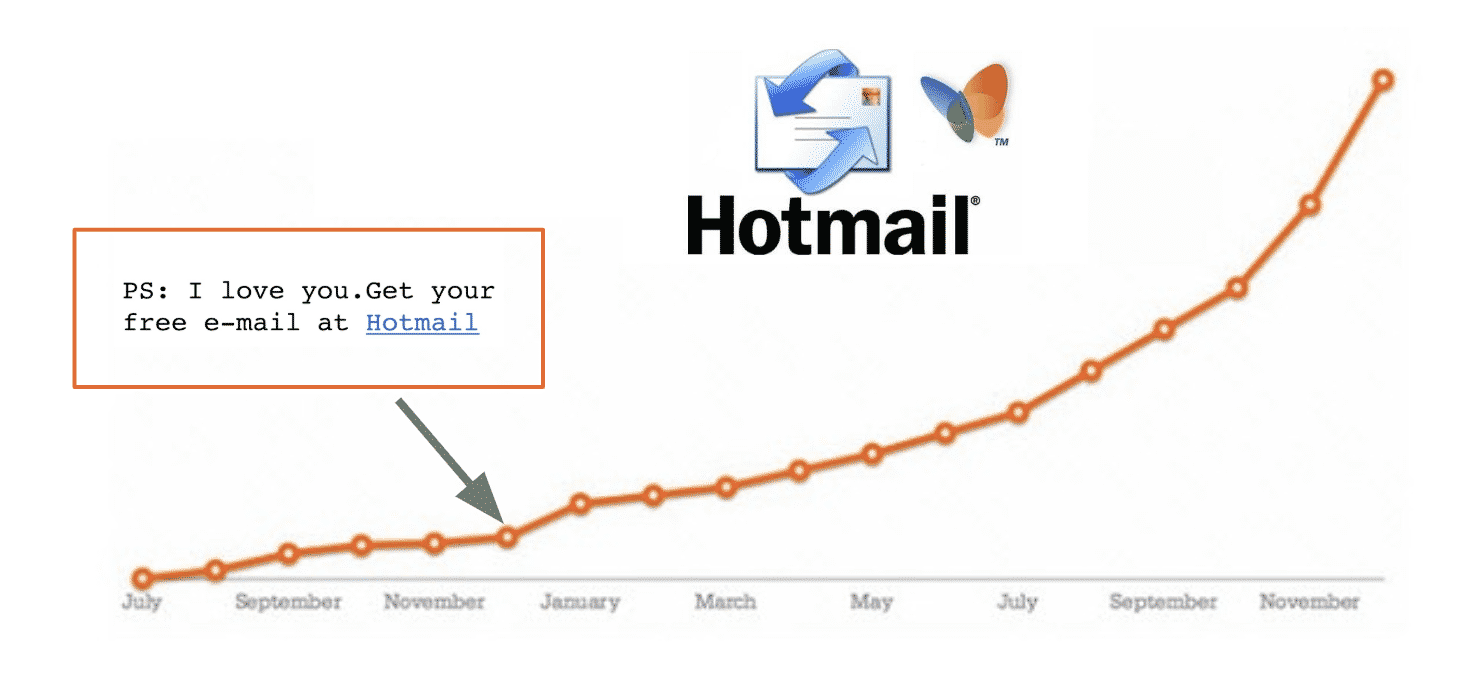
In 18 months Hotmail went viral to 12 million users! Just to give you an idea: at the time there were ‘only’ 70 million people in the world with internet.
PayPal and their eBay-bot
This is a similar example as the Dropbox example. PayPal wanted to be placed as a payment option on eBay, because they would receive a small commission per transaction.
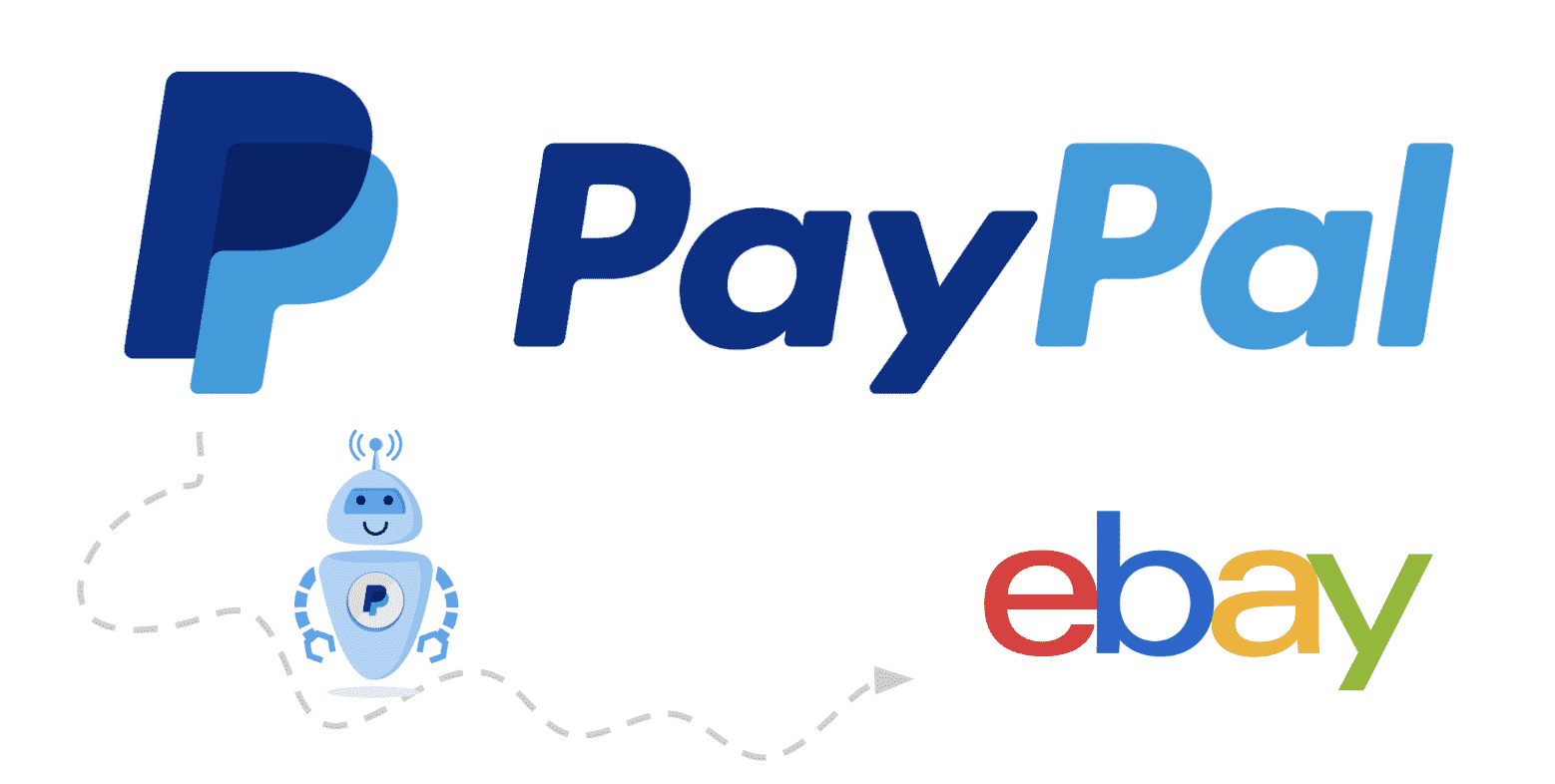
Ebay had no interest at first. Then the PayPal team manually approached big sellers on eBay to buy their product with the question “Can I pay you via PayPal?”. The sellers did not know PayPal and therefore were losing the deal. The vendors demanded from eBay that they would integrate PayPal and after enough sellers had requested this, eBay turned to PayPal.
Less famous growth hacking examples…
Hier zijn enkele artikelen met andere voorbeelden van bedrijven die growth hacking toepassen:
- ‘23 Proven Growth Hacking Examples You Can Steal to Gain Traction‘ door Optinmonster
- ‘19 Growth Hacking Examples That You Can Copy-Paste‘ van Grow-Force
- 30+ Growth casestudies van hoe bekende bedrijven zijn gegroeid, zoals Uber, LinkedIn en Miro
Verderop in dit artikel, zal ik ter inspiratie een paar verzamelingen van 500+ growth hacking tactieken opsommen, maar eerst: Hoe kun je zelf beginnen met growth hacking?
How to start with Growth Hacking?
Before you start
Ask yourself the following questions:
- Do I have Product/Market-Fit? If not, focus first on improving your product to have a sizeable audience that is enthusiastic about your product. Growth hacking can’t fix a bad product.
- Have I set up my analytics/Do I speak to customers regularly? Without data/feedback, you can’t hack growth: You need to know what is slowing down your growth and how best to improve it.
- Do you have the skills/knowledge to set up some simple growth strategies? Your business won’t grow from just analyzing data or coming up with strategies, because nobody knows what will and will not work. You have to execute and grow from there.
Okay, now let’s start!
1. Discover your Growth Bottleneck – The Pirate Funnel
First, we need to understand what is holding back your current growth from growing faster. We want to tackle the weakest point of the business first, because it’s likely the easiest part to improve and at the same time have the biggest possible upside.
For this, growth hackers use the Pirate Funnel. The Pirate funnel is a model by Dave McClure to cut a company in six phases: Awareness, Acquisition, Activation, Revenue, Retention and Referral. The first letters of the stages spells AAARRR, hence the name Pirate funnel. This model can be put on any business model.
Use the Pirate Funnel Canvas and follow the included instructions to find your bottleneck. Use your Google Analytics, customer database, other analytics tools or, if you must, educated guesses to fill in the metrics. This way you’ll see where you lose most customers and thus potential growth.
Now that we know where we are losing most customers, we have to find out why we lose customers at that step. How?
- Do customer interviews.
- Read your negative reviews.
- Watch Hotjar recordings.
- Poll current customers/random people.
- Do 5-second tests with UsabilityHub.
Make sure that you have some data or evidence. Believe me: It will dramatically increase your success rate of solving the problem and improving your growth in the next steps. This is what it means to be data-driven.
(For more details on the above step, read: “What is the Pirate Funnel and how to apply it in 5 steps?“)
2. Set up your Growth Experiments – G.R.O.W.S. Process
Okay, thanks to the Pirate Funnel we’ve found our focus metric to work on. This point will be your only focus and is known among growth hackers as the ‘One Metric That Matters’ (OMTM).
By trying a channel/tactic in a small experiment, you can avoid losing a lot of time or money. If during an experiment it appears that it doesn’t work, then you do not have to invest in it. If it does, you can continue exploring. In this way, a growth hacker ensures a higher ROI (“Return on Investment”) by spending time on the most effective channels. Here you can also see the big similarity between Growth Hacking and Lean Startup.
Here we start the widely-used G.R.O.W.S.-process:
- Gather Ideas
- Rank Ideas
- Outline Experiments
- Work work work
- Study Outcome
(For a more detailed explanation of the steps below, read “G.R.O.W.S.-process explained: A step-by-step growth hacking process“)
Start by gathering your ideas and rank them with the ICE prioritization factors: Impact if successful, Confidence that it’ll work & Ease/cost. Now we know what our best possible solution is, we need to turn it into a growth hacking experiment: a small, quick-to-execute test to see if our idea would work if we’d fully implement it.

To make it easy for you, I’ve created a little cheat sheet including a set of questions to design an experiment effectively: a Growth Experiment Card.
Time to move on!
3. Analyze & Implement
Now probably you’ve tried a few solutions (remember: start small!) and see if it delivers anything.
For example: Does my conversion rate improve if I give people a free trial of the product? Or: How much longer does a user stay active in my software if I send them daily, educational emails? Just try!
If you’ve filled in the Growth Experiment Card, you now know if your experiment was a failure or a success.
Make sure to follow-up on the experiment outcome: If it failed, plan in your second-best experiment idea to test. If it was successful, make sure that that new insight is being adopted in your business: Let the development team implement the full improvement, spread the knowledge of what works with colleagues and look where else this same winning principle could be applied.
And then…
4. Repeat this G.R.O.W.S-Process
The circle is round! Each experiment will give you new insights, every analysis will uncover new bottlenecks to be improved and every time you fix the worst bottleneck, there comes a new ‘worst’ bottleneck to be solved.
Next to these bottleneck-driven experiments, you can also do opportunity-driven experiments. This is when you see an opportunity that might bring a bigger upside then fixing a bottleneck. These become more and more common for growth hackers when your company is maturing as a scale-up or corporate.
Need inspiration? Growth Hacks & Tactics for 2024
Here are a few amazing lists of growth hacking ideas & tactics that you can use as inspiration for your new growth hacking adventures:
- Read 200+ Growth hacking ideas by Ladder.io, a polish growth hacking agency
- Buy Scrapbook: 400+ SaaS & eCommerce Growth Tactics by Kacper Staniul
- Read Wishpond’s 100 Growth Hacks, Strategies & Techniques
Or follow some blogs and communities below to stay up to date with the latest growth hacking trends.
How to learn more about Growth Hacking & become a Growth Hacker?
Growth Hacking Blogs to follow in 2024
Do you want to read more about Growth Hacking? Have a look over here:
- GrowthHackers.com, the largest Growth Hacking forum, founded by Sean Ellis
- Growth Hacker is the new VP of Marketing by Andrew Chen
- Growth Insight Episodes on Youtube by Growth Tribe
- How to hire a growth hacker for your company? by Foundr
- Growth Hacking mythes by ConversionXL
- Or for more Growth Hacking fundamentals like this, have a look at my Grow with Ward blog (where I tackle every growth-related topic one-by-one)
Books about Growth Hacking
- Hacking Growth by Sean Ellis and Morgan Brown
- Growth Hacker Marketing by Ryan Holiday
- The Secret Sauce by Vincent Dignan (very practical book)
- And many more: on my website I’ve made a list of the 23 most important growth hacking books if you want to learn more about growth hacking.
Growth Hacking courses and training
There are a lot of growth hacking courses online and offline. They all vary a lot in price, depth and format. I made a list of a few of these growth marketing courses:
Online growth hacking e-courses:
Below are a few, but I also made a list of the best online growth hacking courses in 2024 some time ago.
- Udemy’s Growth Hacking Digital Marketing – from $149
- Full Beginner Growth Course [2024] – from $299
- CXL Growth Marketing Mini Degree – from $899
- Growth Tribe Academy – from $1290
- Reforge Growth Series – from $2499
Offline Growth Hacking courses:
- Growth Tribe is the first growth hacking academy in Europe and by far the biggest. Each year they train around 2,500 people from their Growth Tribe campus in Amsterdam or in-house at companies. They provide 2-day, 6-week and 3-month courses on various topics such as AI, blockchain and growth. Since 2018 they also have campuses in London, Paris and a few nordic countries.
- The Talent Institute has a paid traineeship for growth hackers as a part of StartupBootcamp. Right now they are still only in Amsterdam, the Netherlands, but there are rumours they are moving abroad as well.
- GrowthRocks is also setting up a growth hacking universities in Athens, London and Bucharest.
- And there are also a lot of agencies who provide in-house workshops worldwide, like Growth Tribe and GrowthRocks.
FAQ on Growth Hacking
Growth Hacking is a relatively new field focusing solely on growth, based on a data-driven, experiment-based process. A growth hacker is systematically exploring new growth opportunities in any part of the customer journey, from awareness through marketing to brand ambassadors by optimizing the product. 
There are five differences between growth hackers and marketers:
– Growth hackers use the entire funnel, where most marketers only look at Awareness and Acquisition.
– Growth hackers run experiments; he tests which direction works best, where a marketer often focuses on one method.
– Growth hackers work data-driven, where that is not the case for most marketing departments.
– Growth hackers have some technical skills, such as programming, tooling and automation.
– Growth hackers are involved in the product, because, among other things, he has to pay attention to the retention of active customers.
The most well-known examples are Dropbox’s referral-program, PayPal’s eBay-bot and Hotmail’s “P.s. I love you”. I’ll go more in-depth on these examples inside this blog.
Knowledge of data is necessary, because that is the only way to find your main problem and its cause. Then comes creativity to come up with solutions for this problem and finally, a growth hacker needs technical skills to bring these solutions to reality.
He / she does not have to be an expert in everything, but in any case has to understand the basis to be able to execute the biggest part by themselves. Hence a T-shaped player…
Ready to go?
If anything is unclear, if you need my help or if you want to add something to this blogpost, feel free to send an email to ward@growwithward.com.


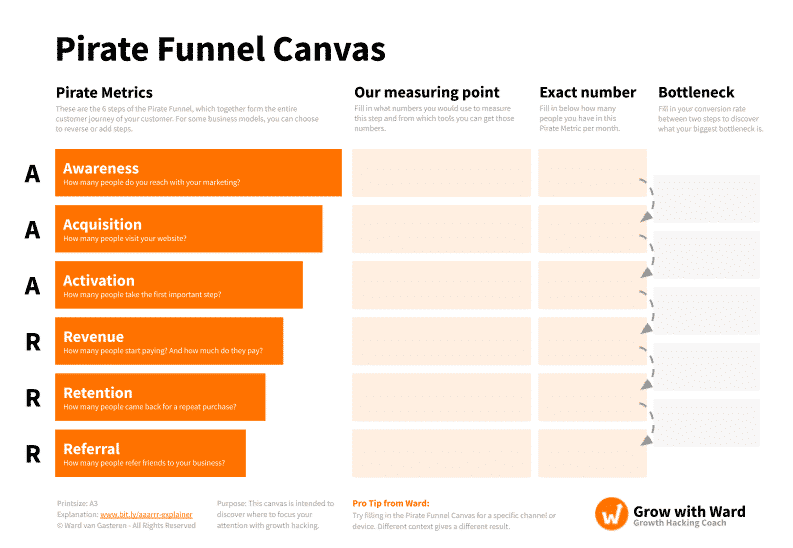
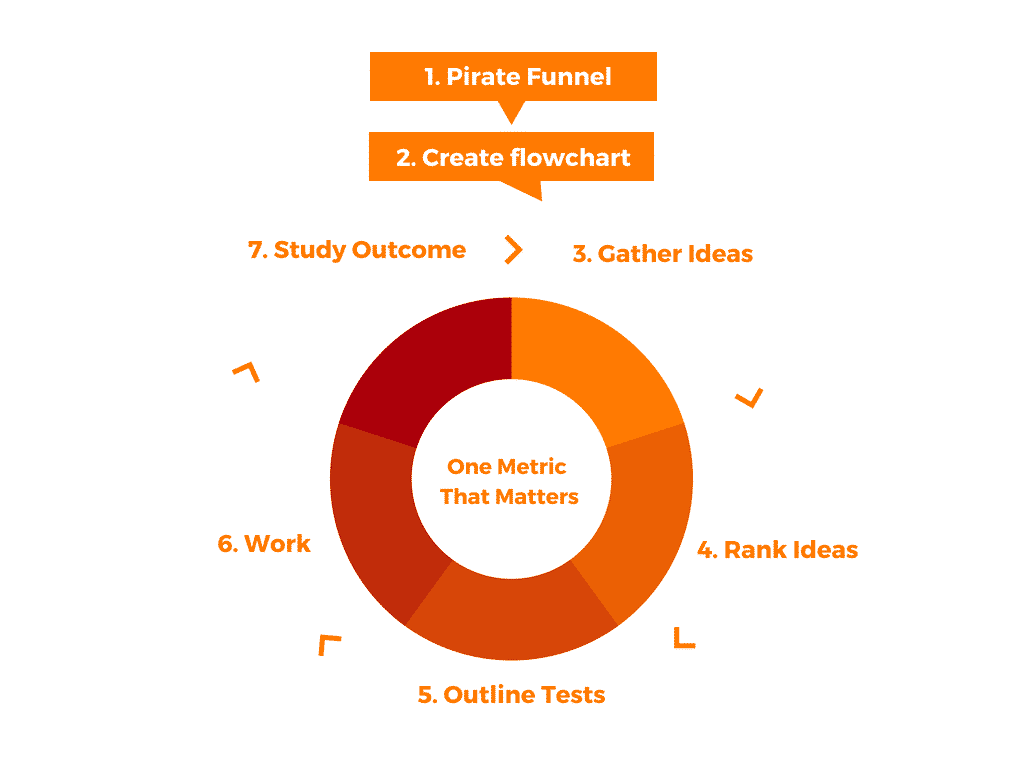
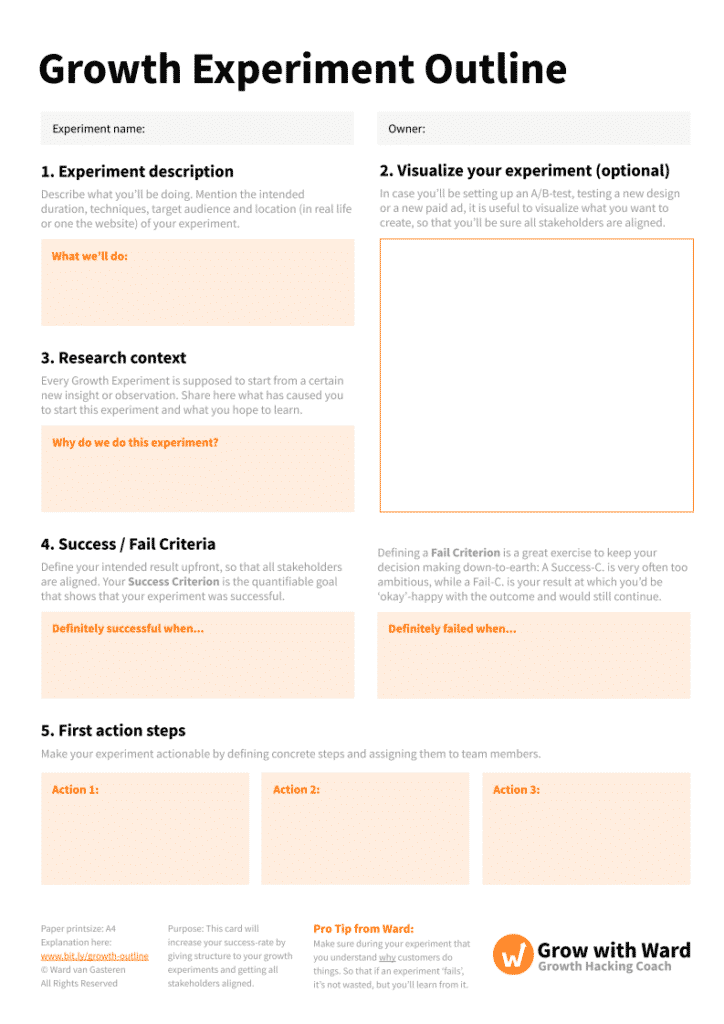

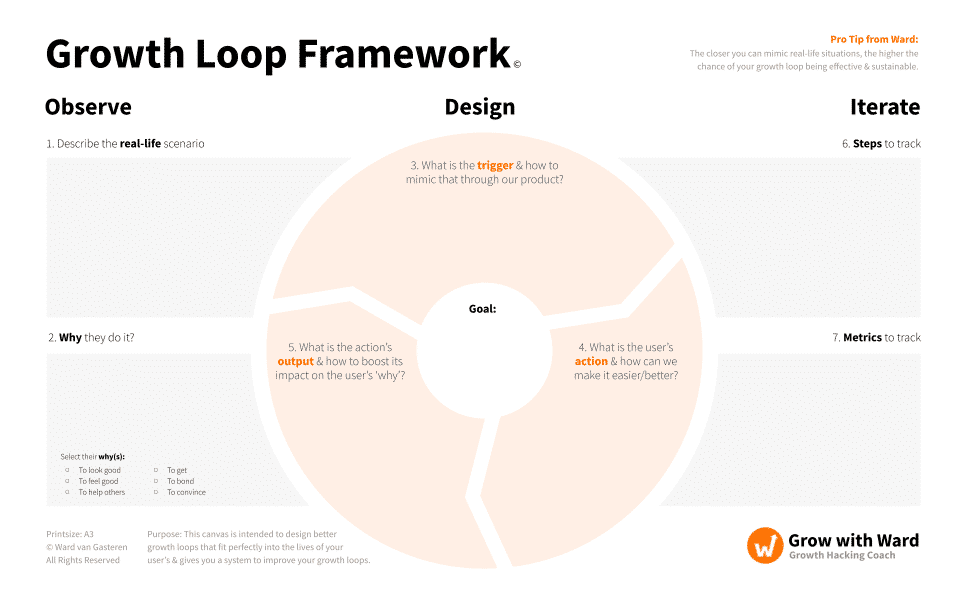
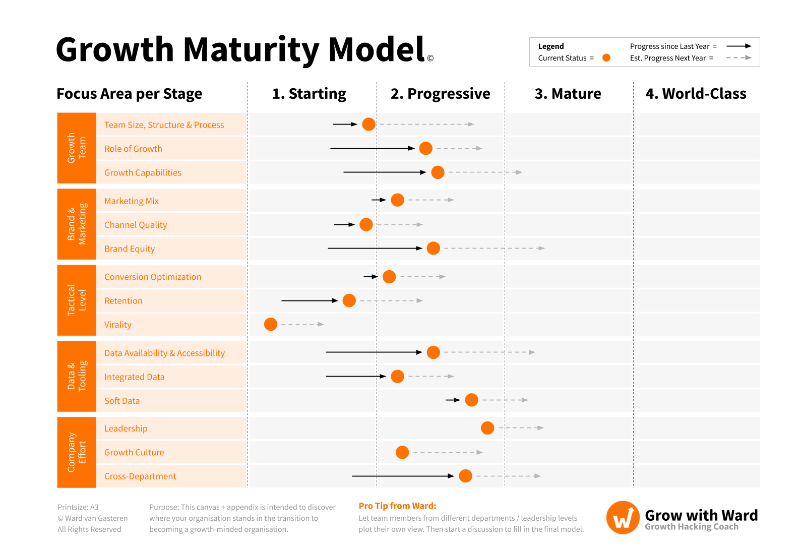
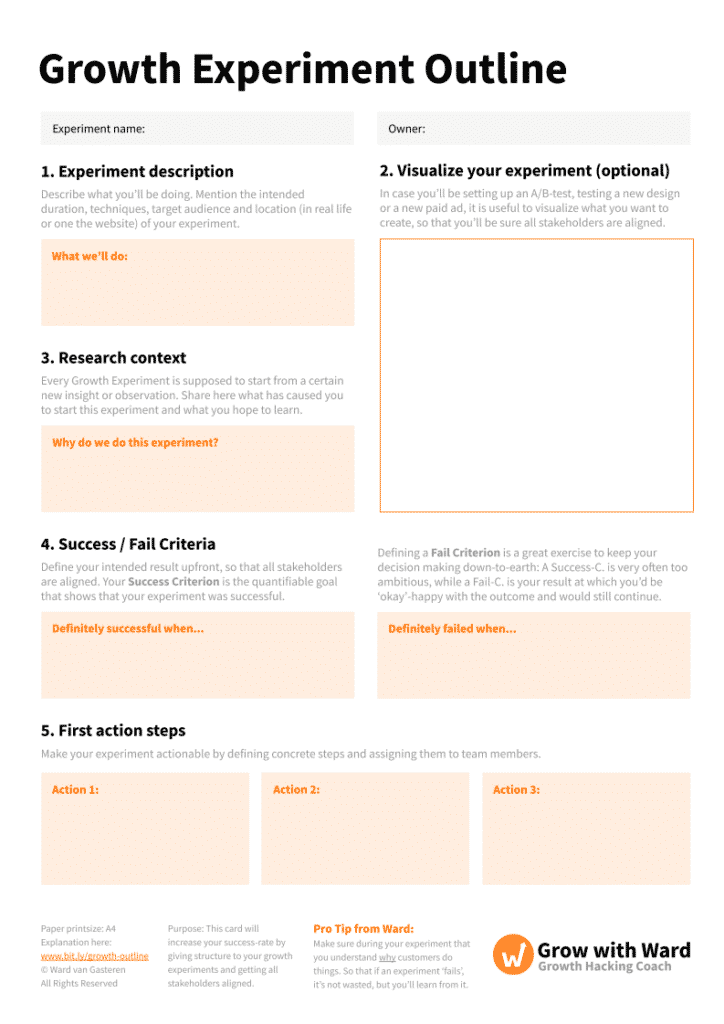
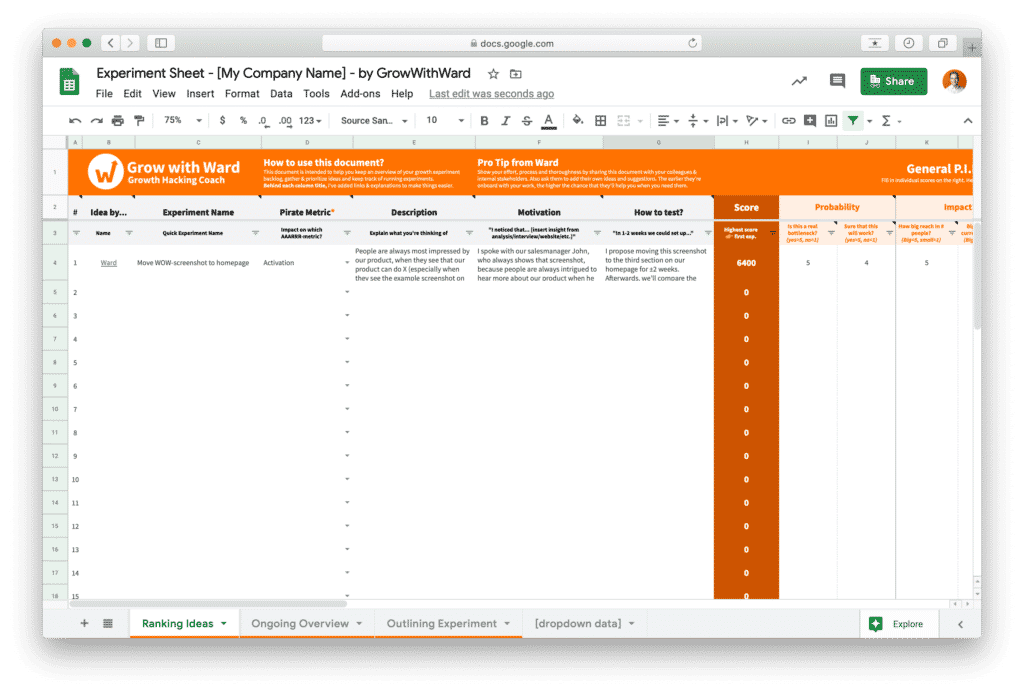

16 thoughts on “Growth Hacking: What is it & How does it really work?”
Brilliant Read, I am currently in the process of treading my first steps as growth hacker my self and this has been sooo helpful, can’t thank you enough. Tres Bien!
Thank you for your message, Yohan! Happy to help
Hello, I’m a Korean university student. I wanted to study Growth Hacking, so I was going to googling and read this blog!
It was a great help to me because you explained it so kindly.
Thank you very much! and happy new year 🙂
I’m glad I could help you get started Bin!
Thanks Ward, a great all-in article about Growth hacking I”ve read so far. Highly practical!
Thank you, Quynh Dao! Feel free to reach out to me if you have any questions – no matter how big or small
Sir I got awareness about growth hacking and i don’t know where to start .I want to learn for free, can you guide me sir
Hi Saisandeep! Please reach out to me on ward@growwithward.com and I’ll see how I can best help you to get started in growth hacking. In the future, I’ll also write a guide on how to learn growth hacking/become a growth hacker.
Awesome content as always, I am starting to fall in love with your growth hacking content – GrowWithWard has become my go-to place for marketing strategies.
Thanks Ayman I’ll keep doing my best!
Hi,
The article is well written and worth reading. Thank you for sharing the valuable information. Please keep sharing more
Thanks Ali! These kind of comments are the ones that keep me going!
thanks so much for the value you share with as ward
Thanks Ahmed – I’ll keep doing my best